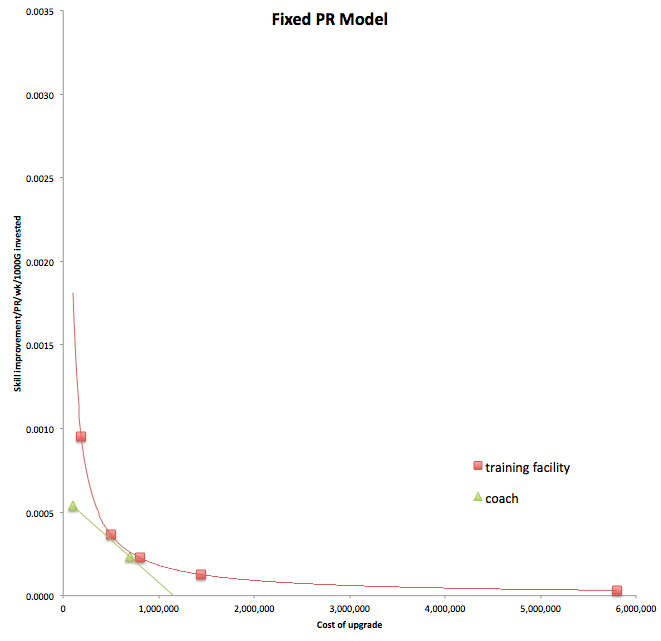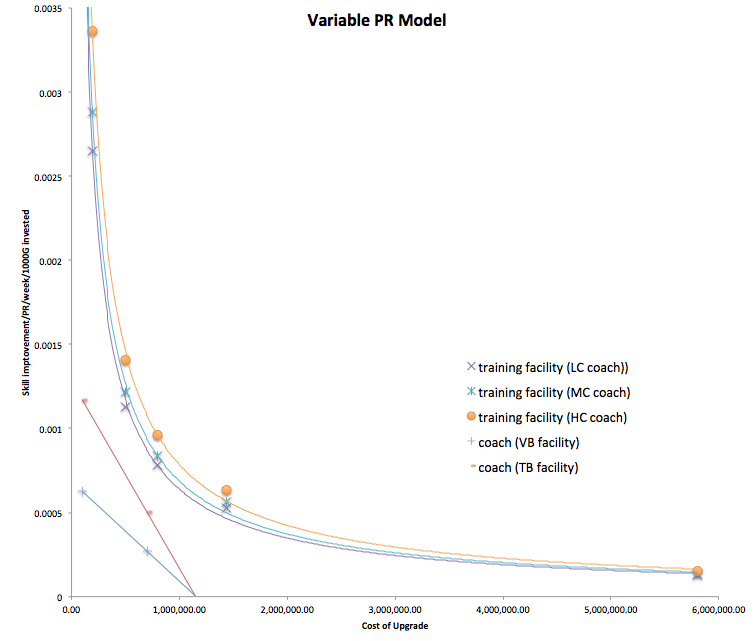When you upgrade facility you do it for all players and forever. When you hire coach you do it for a few players only ( almost users have one coach for 5 players . I am sure you know why  ) and coach is going to retire for several years.
) and coach is going to retire for several years.
So if we take one coach for 5 players and faclilty for 40-50 players training and put to your ideas :The difference?
With the constant PR model, the base effect per G invested of the coach upgrade is greater than 10X that of the facility upgrade.
With the variable PR model, the base effect per G invested of the coach upgrade is approximately 1.7X that of the facility upgrade.
we can see that with PR constant base effect and coach effect are pretty the same.
Good point.

I just hope admin either edits the manual or fixes the bug - and soon.
Either way, I look forward to training bonuses from hard and very hard training workloads. The benefits from these settings are rather trivial without them imo...
EDIT:
On second thought, I realized there are a couple pitfalls in both of our logic.
First, while teams in GKO can have up to 50 players,
most have fewer than that. A new team starts with 22 players. My team has 34 players at this time, though I've had over 40 at one point. Furthermore,
only a fraction of a team's players benefit from training. Of these 34 players, 15 have CA<LA and thus benefit from these training equations. Of these, 10 are youths, split between 2 coaches.
Second, while a coach can train
up to 5 players at proficiency, often coaches will be assigned to fewer than 5 players, especially low and medium cost ones. My medium-cost coaches are currently assigned to an average of about 3 players per coach, but my high quality coaches are usually assigned 5.
Also, my own logic had a pitfall: average coach skills aren't very useful for this kind of analysis since managers will maximize their usefulness, assigning coaches to training programs that use their maximum skills rather than their averages.
So I did a second analysis to compare the relative value of coach and training facility upgrades to the team as a whole, and then to examine the differences between the fixed and variable PR models.
(Skip to the bottom for its conclusions)First, using the above equations I calculated the average daily skill improvement players that have not yet reached their LA (or the training cap) based on facility level, player PR, and coach skills using the fixed and variable PR models. It does not factor in constants, including training form, youth age bonuses, or training workload bonuses. Instead of coach skill averages, I used these average (maximized) values for coaches:
Low cost: 5.5
Medium cost: 9
High Cost: 16
To minimize the number of variables, I expressed my results for individual players as skill improvement points/PR and then calculated the amount of improvement from a one-step upgrade (e.g. upgrading from an okay quality training facility to a good one or from a low-cost coach to a medium-cost one) and included youth bonuses for 2/3 of players (assumes 1/3 of players whose CA<LA are not youths).
Next, I computed the average weekly training value to the team per 1000G cost of the upgrade by dividing the per-player result by the cost/1000G and multiplying this quotient by 7 (no. of days in a week) and the expected number of players that benefit from training (15 for training facilities, 3.5 for medium-cost coaches, and 5 for high-cost coaches). The only variable I did not include was coach retirement. While this is a limitation coaches have, most coaches will stick around for 20 seasons or more (=7+ RW years) making this factor negligible. I expect that after 7 years any manager will have the best quality everything, at which point, there ceases to be a trade-off between coach and facility upgrades...
The final results are thus expressed as skill units (whole team) per 1000G upgrade cost/week/PR. The results that follow are essentially for all PR1 players; hence the values are increased 3X more for PR3 players and so on.
Here's what I found (note that both graphs are drawn to the same scale):

and

Note that in the variable PR model, the value of training ground upgrades depends partially on coach quality while the value of a coach upgrade depends partially on training ground quality, hence multiple lines for each.
Notable differences between the variable and fixed PR models:
1) the value of BOTH coach and facility upgrades are increased.
2) the variable PR model increased the value of coach upgrades between 17% and 118% depending on existing facility quality
3) the variable PR model increased the value of training facility upgrades between 178% and 395% depending on coach quality and which particular upgrade is being made.
Conclusions1)With the (existing) fixed PR model, there is greater value upgrading from a low-cost to medium-cost coach than there is upgrading training facilities above bad quality; similarly, similarly, a high-quality coach has greater value than training facility upgrades beyond okay quality. Upgrading to good quality is roughly equivalent to a high-cost coach upgrade. Similar trends are found with the variable PR model, but the points at which the value of coach upgrades exceed that of facility upgrades are at very good and the best quality for medium- and high-cost coaches, respectively
2) The variable PR model increases the training value of coach upgrades by 17-118% and that of facility upgrades by 78%-395% per G invested over the fixed PR model.
3)
The full implementation of the variable PR model is thus likely to increase investment in training facilities and coaches (and by default, academies) while decreasing investments in players on the transfer market. This would have the secondary effect of reducing transfer (and wage) prices on the transfer market substantially. Managers would also be more likely to keep their players in training until they reach their LA rather than (wanting to) sell or release low LA players immediately after promotion from academy, thereby reducing the "hardship" of the low % received from transfers of new players. All of these effects seem to be those admin wants for the game....